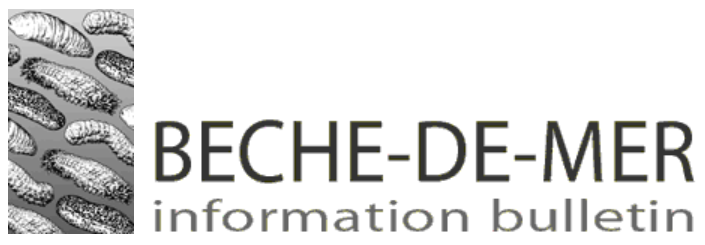
Group Coordinator and Bulletin Editor
Production
Pacific Community, Fisheries Aquaculture and Marine Ecosystems Division, Information Section, SPC, BP D5, 98848 Noumea Cedex, New Caledonia.
Produced with financial assistance from the Australian Government, the European Union, France and the New Zealand Aid Programme.
Editorial
This 43rd issue of the SPC Beche-de-Mer Information Bulletin includes 12 original articles and scientific observations from around the world.
The first article by Ducarme et al. (p. 4) describes the results of a one-year sea cucumber survey conducted in Vanuatu (South Pacific) during 2019/2020. Paderanga et al. (p. 11) give us information on the distribution and abundance of white teatfish in the area of Medano White Island Marine Fish Sanctuary in the Philippines. Three teatfish species were included in Appendix II of CITES in 2019, and Di Simone et al. (p. 17) explain the inclusion of three new species of Thelenota: T. ananas, T. anax and T. rubralineata.
The next article, presented by Christophersen et al. (p. 23), presents the results of initial studies on the reproduction of Parastichopus tremulus in captivity in Norway. The results concern broodstock holding, induced spawning, and gamete quality. Potential new biotechnological tools for improving hatchery production are also discussed.
Ma et al. (p. 32) report on unusually heavy, deformed individuals of Cucumaria frondosa harvested by bottom trawl off the coast of Newfoundland (eastern Canada) that displayed stones nestled inside their body cavity.
Two articles concern different projects related to the investigation of microplastics found in sea cucumbers: one is from Dettling et al. (p. 39) and the other from Mohsen (p. 43).
The next two articles are about sea cucumbers from the Mediterranean Sea. In the first, Khodja and Mezzali (p. 46) determine some biometric relationships of Parastichopus regalis that can be used for the management of its fishery before its launch. In the second, Sellem (p. 52) provides data on the abundance of sea cucumber species in a Mediterranean lagoon on the Tunisian coastline.
Concerning education and training, Indriana et al. (p. 57) explain the training that was offered in Lombok (Indonesia) to several groups concerning the farming of Holothuria scabra. Eeckhaut et al. (p. 63) announce the setting up a Certificate in the Science of Artisanal Mariculture and Village Farming, supported by Belgian and Malagasy universities. The Certificate will welcome 20 candidates annually, and the first courses will be in September 2024. The practice of four maricultures (holothuriculture, algoculture, spiruliculture and coralliculture) will be taught.
In the same field, Di Simone et al. (p. 66) introduce a new simplified identification guide with 56 species of sea cucumbers, protected and unprotected by CITES, and traded worldwide for food consumption. It is purposedly simplified for use by non-specialists, including enforcement authorities whose mission is to detect potentially illegal shipments.
Finally, observations of juvenile Stichopus horrens in Solomon Islands (Komatsu et al. p. 74) and of Stichopus herrmanni (Ducarme p. 76) are presented.
Also included in this issue are various communications (p. 79) about past and future congresses. In particular, Alessandro Lovatelli and Steve Purcell (p. 82) announce the arrival of the second edition of the FAO guide on the “Commercially important sea cucumbers of the World”. This edition includes 84 species. The articles by Di Simone et al. in English, are also presented in French (p. 20 and 70).

